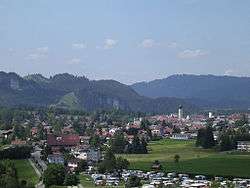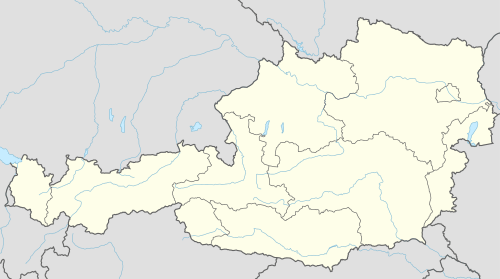Reutte
| Reutte | ||
|---|---|---|
 | ||
| ||
 Reutte Location within Austria | ||
Location in Tyrol
| ||
| Coordinates: 47°29′00″N 10°43′00″E / 47.48333°N 10.71667°ECoordinates: 47°29′00″N 10°43′00″E / 47.48333°N 10.71667°E | ||
| Country | Austria | |
| State | Tyrol | |
| District | Reutte | |
| Government | ||
| • Mayor | Alois Oberer (Leben in Reutte) | |
| Area | ||
| • Total | 100.9 km2 (39.0 sq mi) | |
| Elevation | 853 m (2,799 ft) | |
| Population (1 January 2016)[1] | ||
| • Total | 6,498 | |
| • Density | 64/km2 (170/sq mi) | |
| Time zone | CET (UTC+1) | |
| • Summer (DST) | CEST (UTC+2) | |
| Postal code | 6600 | |
| Area code | 05672 | |
| Vehicle registration | RE | |
| Website | www.reutte.at | |
Reutte is a market town in the Austrian state of Tyrol. It is the administrative center of the Reutte district (Districts of Austria). Reutte is located on the Lech river, and has a population of 6,210 (2014)
Neighbouring municipalities
Adjacent municipalities and villages are: Breitenwang, Ehenbichl, Lechaschau und Pflach.
History

Reutte is located on the Via Claudia Augusta, a Roman road leading from Italy to Germany. The Tyrolean Salt Road from Hall in Tirol to Lake Constance crossed the entire district of Außerfern.
Reutte was declared a market town by Sigmund in 1489. This was confirmed later by Maximilian I who also added some further rights.[2] The people of Reutte commemorate this with an annual festival on the first Saturday in August.
From 1692 the painter Paul Zeiller had a workshop in Reutte that later became an art school. His son Johann Jakob Zeiller and cousin Franz Anton Zeiller both received their first lessons there.
During the period when Austria belonged to Germany (1938 – 1945) there was an outpost of Dachau concentration camp near Reutte, called “Plansee Breitenwald”.[3] In April 1945, American troops of the 44th Infantry Division reached Reutte. The American soldiers had been told to expect heavy attacks but in fact there was no special resistance by Axis forces at all.[4]
As Reutte is connected with other major parts of the Tyrol only by the Fern Pass, international transport and economic connections to the EU, especially to Germany, are becoming increasingly important.
Coat of arms
The coat of arms of Reutte shows three fir trees on three hills, representing the abundance of available timber in the region. (The name "Reutte" has its origin in "roden" or "reuten" meaning glade). The background of red and white stripes stands for the state and the republic.
Population
| Historical population | ||
|---|---|---|
| Year | Pop. | ±% |
| 1869 | 1,411 | — |
| 1880 | 1,470 | +4.2% |
| 1890 | 1,495 | +1.7% |
| 1900 | 1,576 | +5.4% |
| 1910 | 1,924 | +22.1% |
| 1923 | 1,966 | +2.2% |
| 1934 | 2,400 | +22.1% |
| 1939 | 2,476 | +3.2% |
| 1951 | 3,478 | +40.5% |
| 1961 | 4,285 | +23.2% |
| 1971 | 5,113 | +19.3% |
| 1981 | 5,132 | +0.4% |
| 1991 | 5,306 | +3.4% |
| 2001 | 5,719 | +7.8% |
| 2006 | 5,797 | +1.4% |
| 2011 | 5,912 | +2.0% |
Tourism
Reutte is linked to Garmisch-Partenkirchen and Kempten, Allgäu by train services operated by Deutsche Bahn. Reutte is a popular holiday resort and its proximity to the famous Bavarian Castles and the Ehrenberg ruins make Reutte a cultural destination as well as a skiing destination.
Twin city
References
- ↑ Statistik Austria - Bevölkerung zu Jahresbeginn 2002-2016 nach Gemeinden (Gebietsstand 1.1.2016) for Reutte.
- ↑ Lipp Richard: Außerfern, Tyrolia Innsbruck 1994.
- ↑ Onlineauftritt Gedenkstättenpädagogik Bayern
- ↑ http://www.time.com/time/magazine/article/0,9171,852130-4,00.html
External links
 Reutte travel guide from Wikivoyage
Reutte travel guide from Wikivoyage
| Wikimedia Commons has media related to Reutte. |

